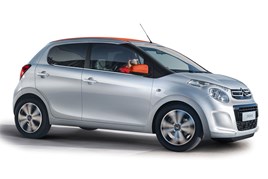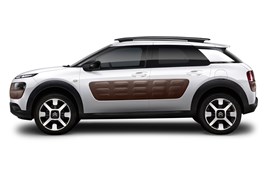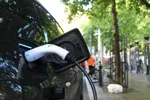In the ‘Push To Pass’ plan he announced in April, PSA chairman Carlos Tavares said a total of 26 cars and eight LCVs are on the way to his group’s dealer networks. Citroën will launch at least 12 new and replacement vehicles, Peugeot nine and DS five, Tavares said.
These will include a rival to the Nissan Navara pick-up, seven plug-in hybrids and eight pure electric vehicles, and the group will continue to develop connected and autonomous technology.
That increased product line-up is likely to add to Citroën’s recent successes with the C4 Cactus and best-selling C4 Picasso, which recorded 3,997 and 5,004 registrations, respectively – increases of 31.8% and 9.6% year-on-year – in the first three months of this year (SMMT).
For DS Automobiles, there is a sense that the race has just begun to establish Citroën’s premium sister’s offering in its own right in the minds of the car-buying public, with new DS4 and DS4 Crossback models entering the market in November and a new version of the DS3 arriving alongside a striking TV ad campaign in February.
The reporting of Citroën and DS as separate brands in SMMT registration figures may make it appear that Citroën is suffering in 2015 – down 15.46% year on-year in Q1, but in fact once the DS figures are included, the combined brands’ registrations are up more than 1% year-on-year in Q1, the bulk of that increase from Citroën registrations. In fact, Citroën’s 69,128 registrations in 2015 were up almost 10,000 on the year before, and almost 18,000 on the 2013 total (51,291).
Looking at market share for the two brands shows a similar picture – although the SMMT’s Q1 figure for Citroën suggests it has dropped two thirds of a percentage point to 2.77%, the combined total for the two brands shows effectively flat at 3.45%.
Forging a new niche
While Citroën and DS are now separate entities in the SMMT’s official registration figures, the process of physically splitting the two brands is yet to be fully realised.
A separation of the Citroën and DS dealership network will be undertaken in 2018, with bidding from both Citroën and Peugeot sites currently under way. However the loss of the DS brand appears inevitable for many dealerships (am-online. com, November 23, 2015).
Bek Hassan, managing director for Citroën and DS UK, would not be drawn on AM’s report, which stated that more than 100 of Citroën’s 187 current retailers could lose their DS franchise, but said: “Currently, DS is only 20% of our business and it would be reckless of us to think that we can have a network of DS as large as our network of Citroën.
“We could do that and just be oblivious to dealerships’ return on investment and so on, but that’s not the way we work. We want to create a network, of whichever size that may be, that’s a viable network for the future,” he said.
On the subject of the DS Automobiles franchised sites being offered to new partners, outside the current Citroën network, (am-online, com, March 23, 2015) Hassan added: “If we only have them at Citroën stores, people will say ‘well it’s still a Citroën’, but that’s not the case so we need a number of stores that show it to be a standalone brand.”

CITROËN C1
Launched in 2014, the C1 has
proved itself key to Citroën’s drive
to offer low cost and improved
quality. The entry-level 998cc Touch
VTi specification appeals to
motorists on a budget with its
£8,345 on-the-road price.
DS franchises will be established either as standalone “stores” or as a Salon Zone concept, which would see a DS area added to an existing Citroën dealership.
It is unlikely that many will mimic the new £10 million joint venture between Peugeot’s Robins & Day dealer group and Citroën Retail Group, which recently saw all three PSA brands brought together in one dealership in Chingford, however.
Hassan said the corporate identity of Citroën’s franchises would remain “cost-effective” and there were no plans for changes away from those planned for DS.
Direct internet sales are being actively looked into, however, with a product expected to be brought online sometime in 2016, but Hassan said: “Clearly we need any online solution to link up with dealers’ own systems. It would be daft of us to sell a new car off the production line, if there are the same cars sat out there in dealer stock.
“We also don’t think this will ever replace the role of the dealer because people still like visiting dealerships, but we also know that a proportion of the market want the ability to both access the information and process orders from their home, so we have to be able to deliver.”
Like many brands, Citroën’s network has shrunk over the past decade and has 45 fewer dealerships today than it did in 2007. Hassan said while there were no plans to further cut the number of outlets, he would not rule out replacing the poorer performers in the current network.
He said: “Citroën and DS combined, the top 75% of our network make over 1.5% return on sales and for a mainstream brand that’s right at the top end but it’s the fourth quartile that don’t do that and probably lose money overall. To recover that, we probably do need new partners.”

CITROËN C4 CACTUS
The multi-award winning C4 Cactus became the brand’s styling flagship when it launched in 2014. A combination of 83.1mpg fuel economy claims and 79g/km CO2 emissions made it a hit with fleet audiences too.
Both Citroën and DS brands have seen an influx of range-defining new products.
DS introduced its first wholly DS-branded vehicle in the form of the DS5 in 2014, following that up with the new DS4 and DS4 Crossback late last year.
An updated version of the hugely successful DS3 and DS3 Cabrio, which has found more than 100,000 UK owners since its launch in 2010, has also recently appeared on forecourts, with a 203bhp DS3 Performance version also on the way.
Hassan, who collected the PSA Peugeot Citroën President’s Award for 2015 in February as Citroën and DS UK were recognised for their positive growth in 2015, said the C1 city car and C4 Cactus had reinvigorated the brand with 19,105 and 11,357 registrations in 2015, respectively.
Hassan said: “There’s a danger that, because of all the emphasis and focus on establishing DS as a brand, people might perceive that Citroën becomes secondary or the poor relation and that couldn’t be further from the truth.
“A few months ago, Linda Jackson, our CEO, called a meeting in Paris of all the dealers to reassure them about the future of the Citroën brand.
“We shared new product with dealers, which is unusual so early on, but we wanted them to see what was coming and we could prove that there was reason to be excited.”
Protecting the brands
Both brands are determined to reduce point-of-sale discounts and increase perceived quality to help improve residual values.

DS3
The hatchback that re-established
the DS brand in 2010 and went on
to find more than 100,000 owners in
the UK. Updated for 2016, the new model features improved connectivity and subtly tweaked styling. Prices
start at £13,995.
Hassan said Citroën had been perceived as a low-cost brand defined by big no-VAT cashbacks in the past, but said the approach had damaged the brand and actually disadvantaged customers.
“You might think you’re buying a cheap car, but in three years’ time your car is worth very little,” he said.
“We are now saying ‘No, that’s not right for the car, the product is better than that’. Our marketing has to now reflect that these cars are quality products.
“Our cars compete head-on with the competition and we know that because we can see the numbers, but we need to get that over to the customers. We need to let them know this is premium and not devalue the product by discounting the hell out of them, making massive deposit contributions or big discounts.
“It’s not easy, but so far we’re getting that balance right.”
Like Peugeot, Citroën is making efforts to reduce its dealings in short-cycle fleet.
Hassan said: “If you’re dealing with large fleet volumes, and particularly short-cycle fleet, you have cars coming back into the market after 12 or 18 months. That does have an effect on your future values.
“You have to manage that very carefully and I think we’re doing that very well by getting the right level of retail. With cars coming back after three years, it spreads the volume coming back into the market.”
Marketing for success
One of the key challenges facing Citroën and DS is the marketing of the two brands.
As Hassan aims to position Citroën as a brand offering “feel-good vibrancy” and DS as serving up premium, avant-garde style, generating awareness is a key undertaking.
DS has teamed up with the Virgin Formula E racing team for the 2016 season and is running an advertising campaign, fronted by 94-year-old fashion icon, Iris Apfel, to promote the new DS3 and DS3 Cabrio.
Over the Christmas period, DS also took centre stage at the Westfield Shopping centre in Stratford, London, placing its DS4 and DS4 Crossback models at the heart of the facility’s ice rink.
Hassan said: “One thing we know is that with DS there is a lack of awareness of the product.

DS4
Divided into DS4 and DS4 Crossback derivatives in late 2015, DS’s
C-segment offering is now available
in hatchback or crossover. Apple CarPlay is among the premium
features standard across the range, from £19,595.
“People who visited us at Westfield said that they did not know the car existed despite the fact that DS3 has been a huge success in the UK. Along with France, we are the best seller of DS3 in the world and we’re the best seller of DS3 Cabrio anywhere in the world. Promoting the brand is a huge task.
“Ultimately, our strategy is to deliver Citroën and DS to as many people as we can. We want people to consider our cars who might not have done before and that means making them very visible in the marketplace and selling them in a variety of ways.
“It sounds simple, doesn’t it?”
‘Push to pass’ and re-entering America
Tavares wants PSA Group revenues to grow by 25% in five years, with an average 4% operating margin between now and 2018 and stretching that to 6% by 2021. Longer term, PSA aims to take some of the pressure off its European markets, by growing sales in India and Asia and relaunching in the USA.
Citroën last operated in the US in 1974 and Peugeot left in 1991.
As part of its American plan, PSA will partner with US ride-sharing services in partnership with Bolloré, the French conglomerate. However it plans to eventually build and retail vehicles there.
“We need to expand to protect the company from any one regional crisis,” Tavares told the Financial Times.
“The company almost paid with its life by having too much of a reliance on Europe.”















Login to comment
Comments
No comments have been made yet.